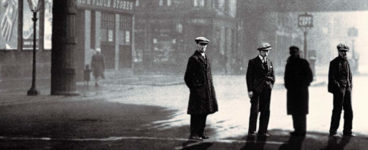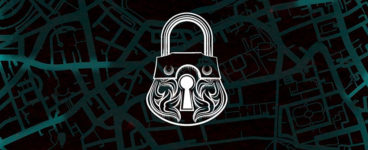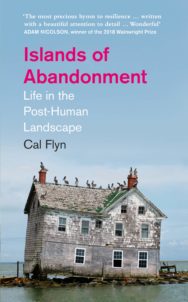‘But over time, species accrue, bed down. And now, the bings come to act almost as an archive of biodiversity for the local area.’
This is a book about abandoned places: ghost towns and exclusion zones, no man’s lands and fortress islands – and what happens when nature is allowed to reclaim its place.
This book explores the extraordinary places where humans no longer live – or survive in tiny, precarious numbers – to give us a possible glimpse of what happens when mankind’s impact on nature is forced to stop. From Tanzanian mountains to the volcanic Caribbean, the forbidden areas of France to the mining regions of Scotland, Flyn brings together some of the most desolate, eerie, ravaged and polluted areas in the world – and shows how, against all odds, they offer our best opportunities for environmental recovery. This extract is about nature reclaiming what was thought to be ruined land – the shale bings of West Lothian.
Extract taken from Islands of Abandonment
By Cal Flynn
Published by William Collins
Fifteen miles south west of Edinburgh, a knuckled red fist rises from a soft green landscape: five peaks of rose-gold gravel stand bound together by grass and moss, like a Martian mountain range or earthworks on the grandest of scales. They are spoil heaps..
Each peak rises along a sharp ridge from the same point on the ground, fanning outwards, in geometric simplicity. Along these ridges, tracks once bore carriages aloft, bearing tons of steaming, shattered rock: discards from the early days of the modern oil industry.
For around six decades from the 1860s, Scotland was the world’s leading oil producer, thanks to an innovative new method of distillation which transformed oil shale into fuel. These strange peaks stand in monument to those years, when 120 works belched and roared, wrestling 600,000 barrels of oil a year from the ground in what had been, shortly before, a sleepy, agricultural region. The process was costly and effortful, however. To extract the oil, the shale had to be shattered and superheated. And it produced huge quantities of waste: for every ten barrels of oil, 7 tons of spent shale would be produced. In all, more than a hundred million tons of the stuff – and it had to go somewhere. Hence these enormous slag heaps. Twenty-seven of them in all, of which nineteen survive.
But to call them slag heaps is to understate their size, their stature, their constant presence in the landscape; unnatural both in form and scale. Locally, they are called ‘bings’ – from the Gaelic, binnean, a high and conical hill.
This particular formation, the five-pronged pyramid, is known as the Five Sisters. Each of the sisters slopes gradually to its highest point, then falls steeply away. They rise from a flat and otherwise rather unremarkable landscape – muddy fields, pylons, hay bales, cattle – to become the most significant landmarks of the region: some pyramidal or square; some organic and lumpen; others still rising raw-flanked and red to plateaus like Uluru.
Mere tips at first, they grew into heaps that shifted and reformed like dunes. Then hillocks. Then, finally, mountains made from small chips of stone – each the size of a fingernail or a coin, with the brittle texture of broken terracotta. These mountains grew and spread, as barrow after barrow was dumped upon the heap. They rose from the land like loaves, swallowing all they came into contact with: thatched cottages, farmyards, trees. Under the northernmost arm of the Five Sisters an entire Victorian country house – stone-built and grand, with wide bay windows and a central cupola – lies entombed beneath the shale. Oil production continued on a massive scale here until the Middle East’s vast reserves of liquid oil came into ascendancy. In Scotland, the last shale mine closed in 1962, bringing to an end a local culture and way of life, leaving mining villages without the mines to employ them, and only the massive, brick-red bings as souvenirs. For a long time the bings were disliked: barren wastes that dominated the skyline, fit only to remind the region’s inhabitants of an industry gone bust and an environment pillaged. No one wants to be defined by their spoil heaps.
But what to do about them? That wasn’t clear.
A few were levelled. A few later quarried afresh, as the red stone flakes – ‘blaes’ as they are technically known –found a second life as a construction material. For a time blaes turned up everywhere: fashioned into pinkish building blocks, used as motorway infill, and – for a time –surfacing every all-weather pitch in Scotland, including the one at my high school. Blaes stuck in grazed knees, collected in our gym shoes, left a tell-tale dust across the jumpers used as goal posts – and generally formed the brick-red backdrop to our communal coming of age. But mainly the bings lay abandoned and ignored. After a while, the villages in their shadows grew used to their silent presence. To enjoy them, even.
It’s easy to find the bings. You can see them from miles off. Just drive until you can’t get any closer, and hop the fence. There’s no fanfare. They are spoil heaps the size of cathedrals or hangars or office blocks, rising from the fields in artificial formations.
* * *
My aunt and uncle live in West Lothian, not far from the Five Sisters and even closer to their even larger cousin at Greendykes. Last time we went to visit my relatives, my partner and I took a detour to climb the sleeping giant. The light was flat and silver, the sky grey and cottoned over with cloud. We parked in a semi-derelict industrial estate, between rust-streaked Nissen huts and faded signposts, and wandered out into a landscape of almost unbelievable strangeness, like the first colonists on a new planet. Sculpted by wind and rain, there were outcrops and boulders comprised of a conglomerate of compressed blaes, a rock form all its own, in Martian red and violet-grey where the outer blaes had chipped away to reveal fresher stones – with that smooth, almost greasy look of chipped flint, olive-tinged – not yet discoloured by oxidation.
Deep ponds of bottle green had gathered in hollows at the base of the slope, at the foot of each dell and gully formed by the tip’s puckered edges, their outlines picked out in the acid green of the pond weed and hair-thin grasses that intermingled in the shallows. Water lilies poked their noses through the surface, where tiny insects skated by. Whip-thin birches sprung with unlikely fervour from their gravel beds, silk-skinned and shining and bearing tiny buds of sweet new leaves. We pressed between the birches, along a narrow footpath, to emerge at the base of the bing proper, and found its vast red flanks rising ahead of us, contours and crannies picked out dramatically in vegetation, and striated with tracks.
We began to climb, but the going was difficult. The blaes had solidified into a dense conglomerate to form rock faces in places, in others scree. Elsewhere, the outer- most layer was grassed over but crumpled, like laundry, where the skin had slipped down, and when we put our weight on it we post-holed as if through rotten snow. Grit collected in our shoes. We had to stop to empty them out, and I felt a flush of something like nostalgia.
After a fashion, we reached the top – a wind-battered upland that offered panoramic views across clean-swept fields to Niddry Castle, a sixteenth-century tower, behind which yet another bing – a sheer cliff of spent blaes, ruddy-faced but streaked with green and grey – stood breathing down its neck. And beyond, yet more, rising proud from the flats.
The flora here was a strange mix; it was hard to get a fix on the sort of climate we found ourselves in. Russet shoots of willowherb were coming up across the tops, as it might along any roadside in the country. But other than that, the vegetation had a sparse, sub-arctic feel: a close crop of soft-furred leaves and starred flowers and short, blonde grass. But there was red clover too, with their sweet heads full of nectar just beginning to open, and spotted orchids. The year’s first bumblebees blundered by, revving their engines. Buds and shoots were snaking up, out of the gravel. The land basking, warming, ready to bloom. It was the end of April. Impossible not to think of T. S. Eliot:
breeding
Lilacs out of the dead land, mixing
Memory and desire, stirring
Dull roots with spring rain.
Back in 2004, the ecologist Barbra Harvie made a survey of the bings’ flora and fauna and found to almost everyone’s surprise that, while no one had been looking, they had transformed into unlikely hotspots for wildlife. ‘Island refugia’ she termed them: little islands of wildness in a landscape dominated by agriculture and urban development. Hares and badgers, red grouse, skylarks, ringlet butterflies and elephant hawkmoths, ten-spotted ladybirds. Among the flora were a diverse array of orchids – the endangered Young’s helleborine, a delicate, many-headed flower in pale greens and pinks, found in only ten locations in Britain (all post-industrial, two of them bings); the early purple orchid in ragged mauve; the greater butterfly orchid, with its winged petals – and a genetically distinct birch woodland that had established naturally at the base of the tiny bing at Mid Breich.
Overall, Harvie recorded more than 350 plant species on the bings – more than can be found on Ben Nevis – including eight nationally rare species of moss and lichen, among them the exquisite brown shield-moss, whose thin tendrils loft targes to the sky like an army in miniature. Over the space of a half-century, these once-bare wastelands had somehow, magically, shivered into life.
Eliot’s wastelanders – or some of them – transpire to be his contemporaries: modern commuters flooding across London Bridge at dawn, lonely typists whiling away evenings in bedsits. In a sense, we are all residents of the Waste Land still – and I felt it keenly then, standing at the prow of this great memorial to ecological degradation.
What are the roots that clutch, what branches grow
Out of this stony rubbish?
Eliot’s Waste Land drew from the ‘perilous forest’ of Celtic mythology, a land ‘barren beyond description’ through which a hero must pass to find the Otherworld, or the holy grail. The bings, too, already offer a glimpse of what we might find on the other side: recuperation, reclamation. A self-willed ecosystem is in the process of building new life, of pulling itself bodily from the wreckage. In starting again from scratch, and creating something beautiful.
Blasted to 700ºC before they were dumped, still roasting, on the tip, the blaes would initially have formed a vast sterile desert devoid of seeds or spores. The regrowth we see now, then, began from absolute zero – no soil, no nothing – as part of a process known as ‘primary succession’.
First came the pioneers: lacy foliose lichens, curling at the edges and growing in coral-like reefs; Stereocaulon, the snow lichens, forming up in crusts. Green mosses laid over the gravel like a picnic blanket, soft and welcoming. Then, the ruderal plants – from the Latin, rudera: of the rubble – the wildflowers and deep-rooted grasses that colonised the loose chutes of scree, stabilising them like marram grass on sand dunes. Kidney vetch and toadflax, bluebells and plantain, yellow rattle, pearlwort, speedwell, sweet clovers. In the damp clefts, seeds of the hawthorn and the rosehip and the birch caught purchase, took root.
All these materialised as if by magic: blown in on the winds, or spread by birds, or dropped in the droppings of animals (what ecologists call, poetically, ‘seed rain’). They are the few survivors of a much greater experimental programme, the hardy few who found a toehold in the spoil heaps and made it work for them. The more there are, the easier it becomes for others, as organic matter builds up as leaf mould and deadwood and algae, and acts as a compost for the next generation. To begin with, the bings would have been species poor, and then a fluctuating assemblage of species would have played across their faces as each tried out new forms of what they might become. Montane species, common weeds, escaped ornamentals. But over time, species accrue, bed down. And now, the bings come to act almost as an archive of biodiversity for the local area.
And though the bings are a remarkable example of the process in action, they are not unprecedented. In nature, primary succession takes places only rarely – on newly formed dunes, or volcanic islands bubbling into the open from underwater vents. But humans have a bad habit of stripping the land bare of all its life, and starting the process all over again.
In the wake of the London Blitz, the then-director of Kew Gardens noted a similar process taking place in the charred and ruinous bombsites that pitted the capital. In a 1943 pamphlet, ‘The Flora of Bombed Areas’, E. J. Salisbury described ‘the rapid clothing of the blackened scars of war by the green mantle of vegetation’. These plants grew up spontaneously, he noted, upon the bare rubble and in the ruins of the houses. The ‘dust-like spores’ of mosses, ferns and fungi drifted in through the broken windows; the soft, silken seeds of the willowherb para- chuted in from site to site (each young plant, he added, might produce 80,000 seeds a season). So too did the pennant-yellow flags of ragwort and groundsel and colts- foot, and the wispy, wand-like fleabane, and the sow-thistle and the dandelion, and the tiny, star-flowered chickweed. All the time, these seeds and spores – the potential for wildflowers, of wild life – is drifting by us on the air, waiting for their chance. As a petri dish left out will soon grow cultures of its own, a sterilised bombsite or lava flow or bing will do the same, but on a grander scale. All they need is a place to land.
Islands of Abandonment by Cal Flynn is published by William Collins, priced £16.99.
ALSO IN THIS ISSUE

 Edge of the Grave: A Q & A with Robbie Morrison
Edge of the Grave: A Q & A with Robbie Morrison
‘Glasgow in this era, in the grip of the Great Depression, was a raucous, lawless city, with poverty …

 Jeda Pearl Interviews: T. L. Huchu
Jeda Pearl Interviews: T. L. Huchu
‘In fact, I would argue a single, unitary Edinburgh doesn’t exist. What you have are multiple Edinbu …













